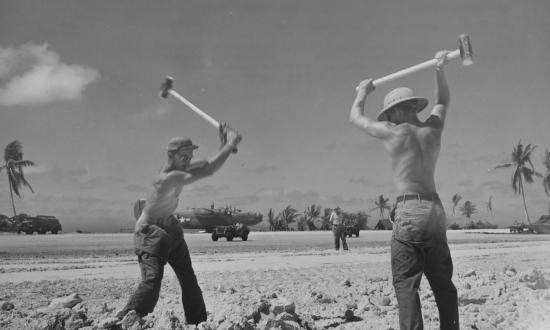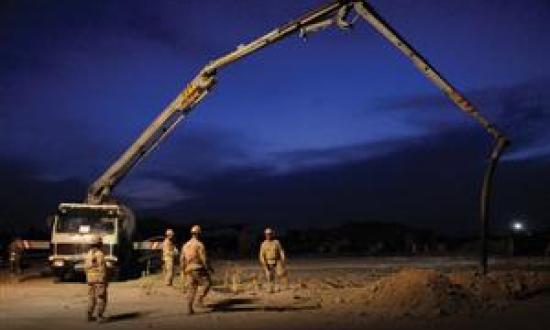Admiral Ben Moreell joined the Navy in World War I and started a fast climb through the ranks of the Civil Engineer Corps. In the early 1930s, he studied military engineering in France, returning to guide the building of the David W. Taylor Model Basin. He became a rear admiral in 1937, skipping the rank of captain when President Franklin D. Roosevelt tapped him to be Chief of the Bureau of Yards and Docks and Chief of Civil Engineers.
Moreell quickly lived up to expectations, driving the prewar construction of two new carrier-capable drydocks at Pearl Harbor. In these edited excerpts from his March 1962 Proceedings article, he captures the history and spirit of what would be his greatest enduring achievement: creation of “The SeaBees in World War II.”
It is no simple matter to relate the World War II exploits of the SeaBees. In the first place, we had nearly a quarter million of them—“construction stiffs” largely—who had to be recruited, trained, organized, and equipped almost overnight and initiated into the niceties of military life. Many of these men were not noted for polished language or conduct. Second, it is difficult to report on everything these SeaBees did because they were so busy accomplishing impossible things that they had little time to make reports on how they did it.
With the attack on Pearl Harbor, it became clear that civilian contractors and their employees could not be used effectively in combat areas. Under military law, civilians could not offer resistance when attacked. A civilian bearing arms would be considered a guerrilla, liable to summary execution if captured.
Therefore, on 28 December 1941, the Bureau of Yards and Docks requested the Bureau of Navigation to authorize the organization of three Construction Battalions [CBs or SeaBees], each to consist of 1,073 men and 32 officers. Each battalion was to be constituted as to trades and specialties as to be self-sufficient for carrying out any construction work assigned to it.
“A SeaBee,” they said of themselves, “is a soldier in a sailor’s uniform, with Marine training, doing civilian work at WPA wages.” Actually, they were, for the most part, typical American craftsmen—plumbers, carpenters, steam-shovel operators, truck drivers, wharf builders, engineers, surveyors, draftsmen.
It is difficult, if not impossible, to find any active combat zone where there were no SeaBees. They participated in every amphibious operation in the Pacific. They were in North Africa, in Sicily, and at Salerno. They handled the artificial harbor, landing barges, causeways, and fueling facilities at Omaha Beach in Normandy. On Tinian, a SeaBee was a stowaway on a B-29 that bombed Tokyo. SeaBees also participated as members of special Navy underwater demolition teams, one of the most hazardous of their many assignments.
“Spider” Rowland, sports writer for the Little Rock Arkansas Gazette, shipped with a battalion of SeaBees to North Africa in 1943. “This is the first time I have been round any SeaBees,” he wrote, “but they are as handy as a bride at a wedding. They can build tank traps with sticks of macaroni, repair a lady’s wrist watch with a Stillson wrench, or pitch hay with a one-prong fork. They do any kind of work needed by the Navy.”
“I understand 50 is the SeaBee age limit but, as we hauled three or four grandfathers, I have a hunch they don’t waste too much time investigating how many summers he has been around if they want a guy. I ran across one talking about the Spanish-American War, and it wouldn’t be over two to one he wasn’t in it. This SeaBee didn’t have any more teeth than a White Leghorn hen, and when I questioned him, he said, “‘I’ll do it if they want me to, but when I signed up I didn’t think they was figgerin’ on me biting the enemy.’”








